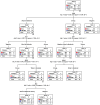Novel multiple markers to distinguish melanoma from dysplastic nevi
- PMID: 23028750
- PMCID: PMC3459895
- DOI: 10.1371/journal.pone.0045037
Novel multiple markers to distinguish melanoma from dysplastic nevi
Abstract
Background: Distinguishing melanoma from dysplastic nevi can be challenging.
Objective: To assess which putative molecular biomarkers can be optimally combined to aid in the clinical diagnosis of melanoma from dysplastic nevi.
Methods: Immunohistochemical expressions of 12 promising biomarkers (pAkt, Bim, BRG1, BRMS1, CTHRC1, Cul1, ING4, MCL1, NQO1, SKP2, SNF5 and SOX4) were studied in 122 melanomas and 33 dysplastic nevi on tissue microarrays. The expression difference between melanoma and dysplastic nevi was performed by univariate and multiple logistic regression analysis, diagnostic accuracy of single marker and optimal combinations were performed by receiver operating characteristic (ROC) curve and artificial neural network (ANN) analysis. Classification and regression tree (CART) was used to examine markers simultaneous optimizing the accuracy of melanoma. Ten-fold cross-validation was analyzed for estimating generalization error for classification.
Results: Four (Bim, BRG1, Cul1 and ING4) of 12 markers were significantly differentially expressed in melanoma compared with dysplastic nevi by both univariate and multiple logistic regression analysis (p < 0.01). These four combined markers achieved 94.3% sensitivity, 81.8% specificity and attained 84.3% area under the ROC curve (AUC) and the ANN classified accuracy with training of 83.2% and testing of 81.2% for distinguishing melanoma from dysplastic nevi. The classification trees identified ING4, Cul1 and BRG1 were the most important classification parameters in ranking top-performing biomarkers with cross-validation error of 0.03.
Conclusions: The multiple biomarkers ING4, Cul1, BRG1 and Bim described here can aid in the discrimination of melanoma from dysplastic nevi and provide a new insight to help clinicians recognize melanoma.
Conflict of interest statement
Figures






Similar articles
-
IMP-3 EXPRESSION IN BENIGN MELANOCYTIC NEVI, DYSPLASTIC NEVI AND MALIGNANT MELANOMA: PRELIMINARY FINDINGS IN BULGARIAN PATIENTS.J Biol Regul Homeost Agents. 2015 Jul-Sep;29(3):695-9. J Biol Regul Homeost Agents. 2015. PMID: 26403409
-
Cell cycle analysis can differentiate thin melanomas from dysplastic nevi and reveals accelerated replication in thick melanomas.Virchows Arch. 2014 May;464(5):603-12. doi: 10.1007/s00428-014-1570-1. Epub 2014 Mar 30. Virchows Arch. 2014. PMID: 24682564
-
α-Methylacyl-coenzyme A racemase (AMACR, p504s) is a marker to distinguish malignant melanomas from dysplastic nevi and melanocytic nevi.Tumour Biol. 2014 Dec;35(12):12015-20. doi: 10.1007/s13277-014-2500-1. Epub 2014 Aug 24. Tumour Biol. 2014. PMID: 25149154
-
Dysplastic nevi.Dermatol Clin. 2012 Jul;30(3):389-404. doi: 10.1016/j.det.2012.04.004. Epub 2012 Jun 8. Dermatol Clin. 2012. PMID: 22800547 Review.
-
Dysplastic nevi.Clin Lab Med. 2011 Jun;31(2):255-65. doi: 10.1016/j.cll.2011.03.003. Clin Lab Med. 2011. PMID: 21549239 Review.
Cited by
-
Decreased expression of nuclear p300 is associated with disease progression and worse prognosis of melanoma patients.PLoS One. 2013 Sep 30;8(9):e75405. doi: 10.1371/journal.pone.0075405. eCollection 2013. PLoS One. 2013. PMID: 24098694 Free PMC article.
-
Role of SKP1-CUL1-F-box-protein (SCF) E3 ubiquitin ligases in skin cancer.J Genet Genomics. 2013 Mar 20;40(3):97-106. doi: 10.1016/j.jgg.2013.02.001. Epub 2013 Feb 10. J Genet Genomics. 2013. PMID: 23522382 Free PMC article. Review.
-
The essential role of tumor suppressor gene ING4 in various human cancers and non-neoplastic disorders.Biosci Rep. 2019 Jan 30;39(1):BSR20180773. doi: 10.1042/BSR20180773. Print 2019 Jan 31. Biosci Rep. 2019. PMID: 30643005 Free PMC article. Review.
-
Reprogramming human A375 amelanotic melanoma cells by catalase overexpression: Reversion or promotion of malignancy by inducing melanogenesis or metastasis.Oncotarget. 2016 Jul 5;7(27):41142-41153. doi: 10.18632/oncotarget.9220. Oncotarget. 2016. PMID: 27206672 Free PMC article.
-
Prognostic Significance of Nuclear Phospho-ATM Expression in Melanoma.PLoS One. 2015 Aug 14;10(8):e0134678. doi: 10.1371/journal.pone.0134678. eCollection 2015. PLoS One. 2015. PMID: 26275218 Free PMC article.
References
-
- Rigel DS (2010) Trends in dermatology: melanoma incidence. Arch Dermatol 146: 318. - PubMed
-
- Miller AJ, Mihm MC Jr (2006) Melanoma. N Engl J Med 355: 51–65. - PubMed
-
- Pellacani G, Farnetani F, Gonzalez S, Longo C, Cesinaro AM, et al. (2012) In vivo confocal microscopy for detection and grading of dysplastic nevi: a pilot study. J Am Acad Dermatol 66: e109–121. - PubMed
Publication types
MeSH terms
Substances
Grants and funding
LinkOut - more resources
Full Text Sources
Other Literature Sources
Medical
Miscellaneous

